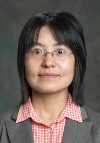Events
- Colloquia - Dr. Blane Baker, Dept. of Physics, Wililam Jewel College - April 13, 2017
Sports Science: Models and Applications

Given the quantitative nature of sport in the 21st century, developing models and conducting analyses of athletic feats using principles of physics can contribute greatly to providing comparisons of athletes and to improving athletic performance. This presentation will address questions such as (i) What makes Usain Bolt the most outstanding sprinter in the world? (ii) How far can a baseball be hit under ordinary and extreme conditions? (iii) Can wind significantly affect world records? These questions and several others will be addressed using basic models and theories of physics. Limitations of models also are considered in the context of developing new models and methods of analysis. Event flyer (PDF)
- Colloquia - Dr. Peifen Zhu, Dept. of Physics and Engineering Physics, The University of Tulsa - October 16, 2015
Light Extraction Efficiency of LED with Self-assembled Periodic Nanostructures

The importance of having low-cost and practical technology to improve the efficiency of solid-state lighting is the key to implementation of this technology in general illumination market.
In this talk, the utilization of self-assembled colloidal sphere/lens arrays deposited by rapid convective deposition (RCD) method to enhance the light extraction efficiency will be demonstrated in both GaN and organic LEDs.
The use of rapid convective deposition method enables roll-to-roll printing process of microsphere and nanosphere arrays on large wafer area. Comprehensive studies were carried out to analyze the light extraction efficiency of LEDs with microsphere arrays deposited via rapid convective deposition process. The device structure was engineered to achieve optimum light extraction. Light extraction efficiency of 86% has been achieved by employing microlens arrays on LED, which is 1.3 times higher than that of state-of-the-art TFFC LED with surface roughness approach. The key advantage of the self-assembled colloidal process is the ability for implementation of roll-to-roll printing method for large wafer scale manufacturing process.
Dr. Zhu is an assistant professor of physics at the department of physics and engineering physics at the University of Tulsa. Her research areas are related to III-Nitride semiconductor nanostructures for solid-state lighting technologies. Her research work covers the theoretical and experimental aspects of the physics of nano-scale semiconductors, MOCVD and device fabrications of III-Nitride semiconductor devices on GaN substrates, nanomaterial synthesis and characterization. Her research interests include phosphor-converted white LED, light extraction efficiency of GaN-based LED and organic LED, solar hydrogen generation based on III-V semiconductors. Event flyer (PDF)